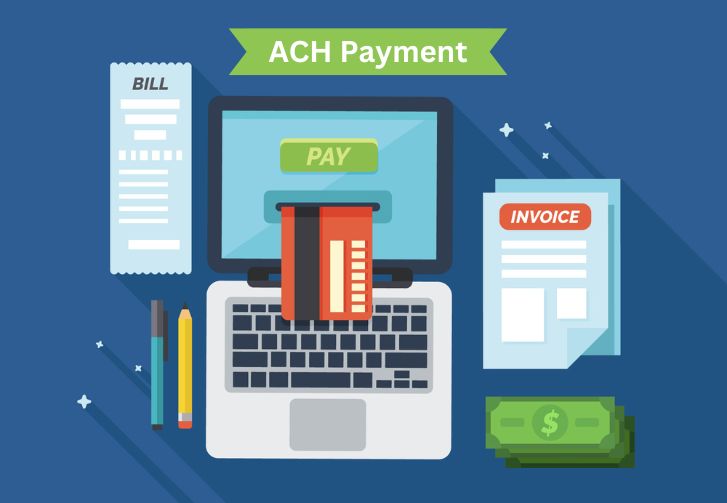
ACH payment processing is a fund transfer system that is widely used in the United States. Some of the top benefits of ACH payment like high security, efficiency, and transparency between payer and payee are making the same more effective. Additionally, users get to have authorization, consent, transaction initiation, ACH network processing, funds transfer, settlement, users get confirmation, report, and much more. In the modern digital landscape, where convenience and efficiency are paramount, the Automated Clearing House (ACH) payment processing system is pivotal in facilitating seamless electronic fund transfers.
From direct deposits and bill payments to business transactions and online purchases, ACH has revolutionized the way money moves between bank accounts. In this comprehensive guide, we delve into the intricacies of ACH payment processing, shedding light on its inner workings, benefits, and broader implications for individuals and businesses alike.
What is ACH Payment Processing?
At its core, ACH payment processing is an electronic funds transfer system designed to streamline the movement of money between different financial institutions. This intricate network handles a diverse array of transactions, ranging from routine direct deposit of salaries to sophisticated B2B payments. The ACH payment processing is being utilized in the USA a lot.
What Stages Does ACH Payment Involve?
Here are some of the peculiar stages that ACH payment involves. These stages will help users get ideas and understand how ACH payment processing works. Check all the ACH payment processing.
1. Authorization and Consent: A fundamental tenet of ACH payments is obtaining proper authorization and consent from the payer (sender) before initiating a transaction. This can be achieved through signed agreements, online authorizations, or verbal consent, ensuring that every transfer is legitimate and sanctioned.
2. Transaction Initiation: Once authorization is secured, the payee (recipient) initiates an ACH transaction. This entails providing the payer’s bank account details, including the routing number and account number, along with the specified payment amount.
3. ACH Network Processing: The ACH network serves as the bridge connecting financial institutions. The payer’s bank (ODFI) transmits the payment request to the ACH network, which then forwards it to the payee’s bank (RDFI) for processing.
4. Funds Transfer and Settlement: The receiving bank verifies the transaction and effectuates the transfer of funds from the payer’s account to the payee’s account. This process generally takes one to two business days, ensuring careful validation and precise execution.
5. Confirmation and Reporting: Upon successful completion, both the payer and payee receive confirmation of the transaction. Additionally, financial institutions generate comprehensive reports detailing the transaction activity for reference and auditing purposes.
Key Advantages of ACH Payment Processing
Find out how ACH payment processing delivers the top advantages to the users.
1. Efficiency and Cost Savings: ACH payments excel in efficiency, thanks to batch processing capabilities. Multiple transactions are grouped and transmitted as a single file, optimizing resource utilization and reducing processing time. This operational efficiency translates into cost savings, making ACH an attractive option for businesses seeking to streamline payment processes.
2. Security and Fraud Mitigation: Robust security measures underpin ACH payments, requiring stringent authentication, authorization, and encryption protocols. This focus on security minimizes the risk of fraud and unauthorized access, ensuring the integrity of financial transactions.
3. Recurring Payments Made Easy: ACH is tailor-made for recurring payments. Whether it’s employers depositing salaries, consumers paying bills, or businesses settling subscriptions, ACH’s automated and reliable nature simplifies the management of repetitive financial obligations.
4. Versatility in Payment Types: ACH accommodates a diverse array of payment types. From individual-to-individual transfers and business payments to online purchases, the system’s flexibility empowers users to execute a wide range of transactions with ease.
The ACH Network and Regulatory Framework
The ACH network, a linchpin of the system, encompasses two principal participants: the originating depository financial institution (ODFI) and the receiving depository financial institution (RDFI). This collaborative framework ensures the smooth flow of transactions and fosters cooperation among financial institutions.
The National Automated Clearing House Association (NACHA) oversees regulation and standardization within the ACH ecosystem. NACHA establishes guidelines, rules, and best practices to maintain the security, efficiency, and reliability of ACH payments.
The Future of ACH Payment Processing
As technology continues to advance, the ACH payment processing landscape is poised for evolution. Innovations such as same-day ACH processing and enhanced data security protocols are shaping the future of electronic fund transfers. Businesses are leveraging ACH’s efficiency and cost-effectiveness, while consumers benefit from simplified bill payments and seamless online transactions.
Understand ACH Payment for Businesses
The ACH payment for businesses works following the 08 important processes. All the stages are making the process for electronic fund transfer most effective for businesses and secure enough. We have added each step to make you understand it well. Check how ACH payment processing for businesses is working effectively.
- The first step is “receiving an authorization form from your customer.
- Forward transaction files to ODFI.
- ODFI collects files in batches and sends them to the ACH.
- ODFI ACH operator forwards files to your customer’s bank
- RDFI pulls funds from your customer’s bank account.
- Withdrawn funds are sent to the ACH operator.
- ACH operator distributes funds to your bank.
- You receive your payment.
These are the top steps that ACH payments for businesses follow. Please, do remember that the entire process includes all the persons the “Originator”, “ACH operator”, and the “Receiver of that fund”.
How is ACH Payment Processing Secure?
The best part of ACH payment processing is to have no mediator in the middle. As it eliminates the mediators in the middle the users do not have to worry about secure payments and can get the payments directly from the payee. In order to make the payment process more simple and effective. Users can set up a recurring payment as other electronic payment methods are assisting them with secure payments. The best part is that you do not have to ask your customers to provide you with the bank account details at the time you transfer the amount.
These are some of the peculiar things about ACH payment processing which has helped a lot and provided the top method for electronic fund transfer businesses and individuals are seeking for.
Conclusion
The Automated Clearing House (ACH) payment processing system is a cornerstone of modern finance, revolutionizing the way money flows between accounts. Its robust security, efficiency, and versatility make it a vital tool for businesses and individuals alike. As the digital economy evolves, ACH will undoubtedly remain a driving force behind the seamless movement of funds, contributing to a more interconnected and efficient financial landscape. If you are looking for more such informational posts to shape your thoughts and insights. We can help you with the best thing you need to have for you. You can command below to get the information you are looking to have for you.








